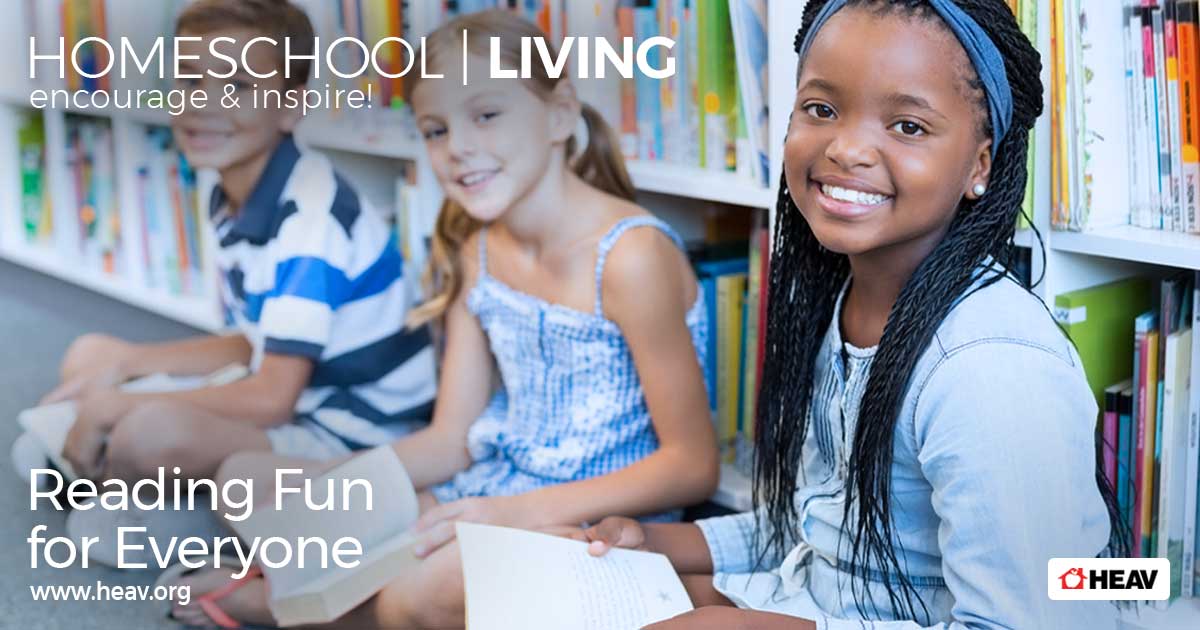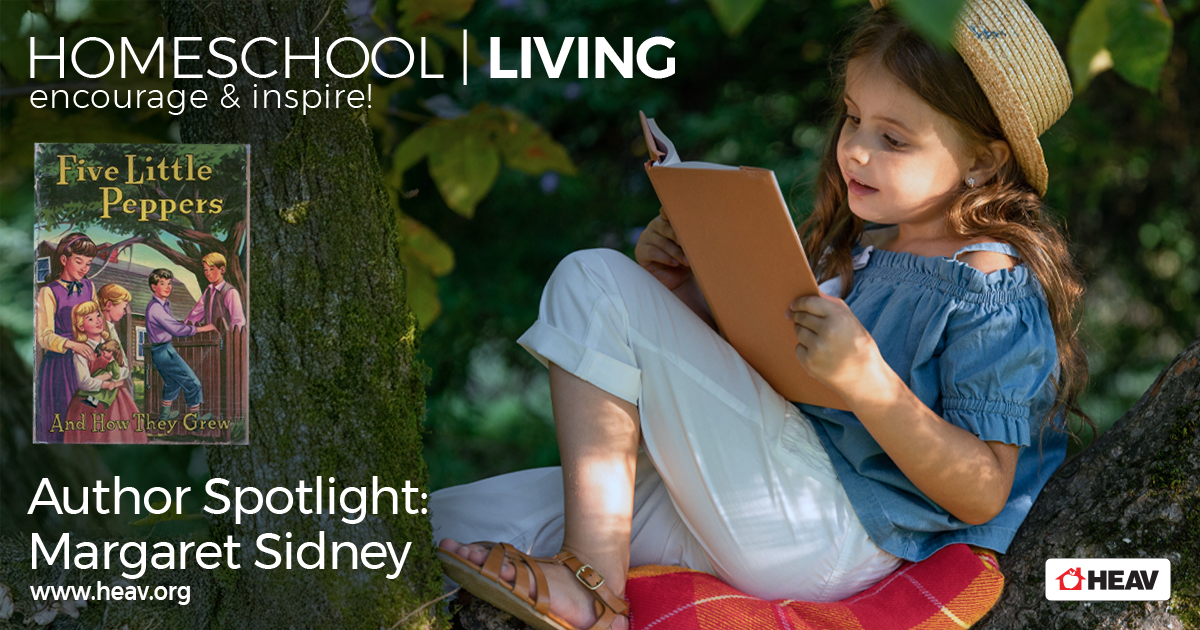Read-Aloud Fun for Everyone
There is an abundance of benefits you can gain from everyday reading aloud, including mental stimulation, knowledge, vocabulary expansion, memory improvement, stronger analytical thinking skills, better focus and memory, improved writing skills, creativity, and good old-fashioned entertainment. A great way for your family to reap these benefits–and more!–is by integrating reading time into your family’s everyday routine. In honor of National Reading Month, here are some homeschool read-aloud tips for encouraging readers of all ages, creative ways to make reading time special, and a variety of ways to incorporate reading aloud into your homeschool living.
Ready, Set, Read!
While the benefits of reading aloud with your children are undisputed, knowing that you should–and even want!–to do something and actually making the time to do it can be two very different things. One of the best parts of homeschooling is that you can create your own schedule to make things work for your family, but getting your priorities sorted and settled into a workable routine still takes some time and effort. These 5 Ways to Set Yourself Up for Success from Simple Homeschool can help you fit family reading aloud time into your schedule.
Jamerrill Stewart shares how she became a “homeschool read-aloud momma” in her blog, Large Family Table.
Homeschool mom Amy, of Hope Is the Word, shares her tips for reading aloud with Homegrown Learners. Helping children learn to focus, process auditory information, and develop their own passions for reading will prove useful far beyond your family reading circle.
Tailored Reading Habitats
One of the best things about reading aloud for entertainment is that you can do it anywhere–no batteries required! Read around the breakfast table, pull your living room furniture into a cozy circle, pile a bunch of pillows on the floor and build a blanket fort, or try this cute idea of using plastic storage bins to make these adorable–and stackable for storage–book boats. These can serve as great cozy places for kids to settle to listen to a read-aloud or to read to themselves.
Whether you consistently read with your children in the same location every day or not, consider having a small space in your home set aside for reading that you and your children can use for reading aloud together or for some quiet time reading alone. Year Round Homeschooling shares 3 Reasons Why Your Homeschool Needs a Reading Corner.
Megan Mora Fuentes
How to Read
First, check out theHEAV reading blog, for great titles like “8 Ways Lego Play Boosts Literacy,” posts by experts like Dianne Craft, Denise Eide, Adam Andres, and much more.
Nina of Sleeping Should Be Easy shares some insight and compelling reasons for why we need to read to our kids every day.
Where to Read
One of the best things about reading for entertainment is that you can do it anywhere–no batteries required! Read around the breakfast table, pull your living room furniture into a cozy circle, pile a bunch of pillows on the floor and build a blanket fort, or try some of these cute and cozy ideas for creating a reading corner in your home and corralling your family’s current reading material.
Year Round Homeschooling shares 3 Reasons Why Your Homeschool Needs a Reading Corner.
Cut and decorate basic plastic storage bins to make these adorable–and stackable for storage–book boats.
Upcycle old milk crates and pillows to create this book storage and reading bench from Brie Brie Blooms.
This collapsible playhouse is easy to create out of a cardboard box and folds easily for storage.
These brick bookends are simple and inexpensive and can be painted to match any decor.
What to Read
Explore this list of childhood favorites to inspire readers of all ages.
If You Give a Mouse a Cookie by Laura Joffe Numeroff
But No Elephants by Jerry Smath
Caps for Sale by Esphyr Slobodkina
We’re Going on a Bear Hunt by Helen Oxenbury
Frog and Toad by Arnold Lobel
Amelia Bedelia by Peggy Parish
Strega Nona by Tomie dePaola
You Are Special by Max Lucado
The Clown of God by Tomie dePaola
The Giving Tree by Shel Silverstein
Where the Sidewalk Ends by Shel Silverstein
The Fantastic Flying Books of Mr. Morris Lessmore by William Joyce
Library Lion by Michelle Knudsen
Mr. Popper’s Penguins by Richard Atwick
The Family Under the Bridge by Natalie Savage Carlson
Sarah, Plain and Tall by Patricia MacLachlan
Charlotte’s Web by E.B. White
Stuart Little by E.B. White
The Cricket in Time Square by George Seldon
The Wind in the Willows by Kenneth Graham
The Borrowers by Mary Norton
Betsy-Tacy by Maud Hart Lovelace
Emily’s Runaway Imagination by Beverly Cleary
The Mouse and the Motorcycle by Beverly Cleary
The Moffats by Eleanor Estes
Mrs. Piggle-Wiggle by Betty MacDonald
Mostly Magic by Ruth Chew (this title is out of print, but you may be able to find it at your local library. Used copies can be found at Amazon and other used book sellers online. Keep an eye out at your local library book sales and thrift stores, too.)
All–of-a–Kind–Family by Sydney Taylor
Little House in the Big Woods by Laura Ingalls Wilder
The Saturdays by Elizabeth Enright
Five Little Peppers and How They Grew by Margaret Sydney
Caddie Woodlawn by Carol Ryrie Brink
Johnny Tremain by Esther Forbes
From the Mixed-up Files of Mrs. Basil E. Frankweiler by E.L. Konigsburg
Island of the Blue Dolphins by Scott O’Dell
Shades of Gray by Carolyn Reeder
The Lion, the Witch and the Wardrobe by C.S. Lewis
The Witch of Blackbird Pond by Elizabeth George Speare
Little Men by Louisa May Alcott
The Book Thief by Markus Zusak
Dr. Seuss and Nonsense Verse
A beautiful way to teach–and learn–appreciation for the written word is to encourage an appreciation and understanding of the feelings that language can evoke. Nonsense verse employs rhyme and rhythm to communicate the meaning of its fanciful phrases and made-up words, and is a fun way to explore the effects language has on emotions even when you can’t understand all the words. Dr. Seuss’s children’s books contain excellent examples of nonsense verse.
Celebrate Dr. Seuss’s birthday on March 2 with these fun crafts and activities to pair with some of his most beloved stories.
This Horton Hears A Who headpiece from Artsy Momma is perfect for preschoolers who like to play dress-up.
This “Wocket”-inspired lacing activity paired with some freestyle drawing is a fun, creative activity for younger children working on fine motor skills.
You don’t need a “star-on” machine to create these cute T-shirts inspired by The Sneetches.
These egg carton turtles from Frugal Fun 4 Boys and Girls are fun for students of all ages to paint and decorate.
Simple clay pots transform into Lorax planters with bits of felt and pom-poms.
The Sneetches by Dr. Seuss
Horton Hears a Who! by Dr. Seuss
The Lorax by Dr. Seuss










